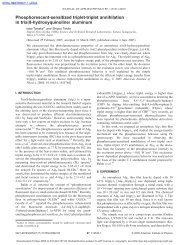Children's Television: Trends Around the World
Children's Television: Trends Around the World
Children's Television: Trends Around the World
Create successful ePaper yourself
Turn your PDF publications into a flip-book with our unique Google optimized e-Paper software.
CHILDREN’S TELEVISION: TRENDS AROUND THE WORLD<br />
127<br />
TeacherSource) and parents (PBS Parents). The PBS Parents site contains<br />
information about <strong>the</strong> children’s programs and about related activities. In<br />
addition, an Issues and Advice section offers discussion of a range of topics<br />
including “Behavior and Development,” “Disabilities,” and “School and<br />
Education.” Each category includes comments by experts, lists of reference<br />
materials, and information about relevant television programs.<br />
The BBC’s website for preschoolers, CBeebies, also acts as a portal. A link<br />
for “grown-ups” provides access to services for parents and caregivers, similar<br />
to those described for PBS Kids.<br />
Web portals are not provided only by broadcasters: <strong>the</strong> producers of series<br />
such as Sesame Street and Mister Rogers’ Neighborhood also offer websites.<br />
Their content draws on <strong>the</strong>ir many years of experience and accumulated<br />
resources, and offers a variety of image-packed information relating to education<br />
for young children. These sites played a valuable role in helping to relieve<br />
children’s tension at <strong>the</strong> time of <strong>the</strong> September 11 attacks, by swiftly uploading<br />
age-specific information and advice, put toge<strong>the</strong>r in consultation with <strong>the</strong><br />
programs’ production and research experts. This web information complemented<br />
<strong>the</strong> programs’ emergency television broadcasts produced with <strong>the</strong><br />
same stress-relieving goal. 17<br />
Toward an Optimal Media Environment for Children<br />
The international children’s television contests, <strong>the</strong> Prix Jeunesse International<br />
and <strong>the</strong> Japan Prize (<strong>the</strong> latter with its motto of “for our children’s<br />
future”), have contributed greatly to <strong>the</strong> development of children’s television<br />
around <strong>the</strong> world since <strong>the</strong>y were launched in <strong>the</strong> mid-1960s. The contests are<br />
not only about selecting winners. They provide an opportunity for producers,<br />
researchers, and educators from all over <strong>the</strong> world to engage in open-minded<br />
discussion about <strong>the</strong> programs in <strong>the</strong> contest, to exchange views and information<br />
about any aspect of children’s television, and to develop ideas for future<br />
programs. In addition, <strong>the</strong> contests have built up video libraries that can be<br />
accessed for workshops and seminars. This means that <strong>the</strong> fruits of each contest<br />
can be exploited worldwide, with <strong>the</strong> aim that any country setting out to<br />
develop its children’s television repertoire has valuable resources on hand.<br />
It is interesting to note that <strong>the</strong>se two contests began just at <strong>the</strong> time when<br />
<strong>the</strong> world, and particularly Japan and <strong>the</strong> United States, was rushing to<br />
pigeonhole children’s television as “cartoons.” In this context, <strong>the</strong> role of <strong>the</strong><br />
contests in broadening <strong>the</strong> scope of children’s television seems all <strong>the</strong> more<br />
significant.<br />
Of course, <strong>the</strong>re is no point of simply producing quality children’s televi-<br />
17 See Kodaira, “Amerika doji tahatsu tero.”







